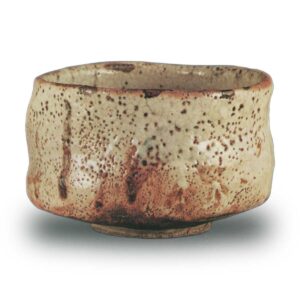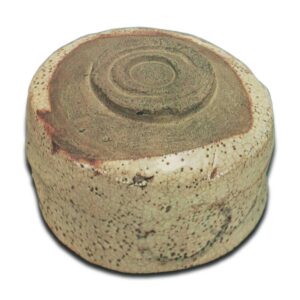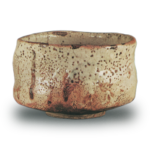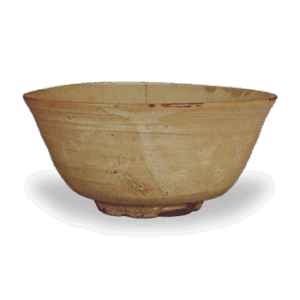

Height: 8.4cm
Diameter: 12.3-12.5cm
Outer diameter of foot ring: 5.5cm
Height of foot ring: 1.0cm
Among the many famous Shino bowls, this one is particularly renowned for its tea-ceremony qualities, and it is said to have been the favorite of the great tea master, Yoshii Don’o, which is why it is so well known throughout the world.
The thick, soft Shino glaze is applied to the rough, ideal clay, and the characteristic thick underglaze painting, which appears and disappears like a plant covered in light snow, deepens the charm of the tea bowl.
While most other Shino glazes are pure and snow-white, they can sometimes have a cold, clear feel to them, but the glaze on this teacup is slightly reddish, giving it a warm, moist feel that I would like to praise as the ultimate in tea aesthetics.
The slightly soft glaze that permeates the rough clay is a feature of Hirosawa that should be highly valued.
The light glaze on the rim and waist, and the glaze on the hem, beautifully reflect the elegant, soft, reddish color of Koshi-no-yaki on the white background.
It is thought to have been made in the Mino Okaya area during the Momoyama period, and although there are several other types with a low-slung square shape, most of them are noisy, with their strength of workmanship clearly visible. However, in this Hirosawa tea bowl, there is also a change in the body, and although there are high and low waves on the rim, there is not the slightest sense of strength, intensity or fussiness in the overall workmanship, and it is a tea bowl that can be appreciated for its gentle and relaxed beauty, or in other words, for the tea-like atmosphere that it exudes. . It is a feeling that is most appropriately appreciated as a graceful and relaxed change, or in other words, a drifting of the tea aesthetic, and it is fair to say that this feeling is one and the same as that of the rough earthy taste or the soft, moist glazed surface. Perhaps the name Hirosawa was also called after the full moon, as it is a perfect and complete expression of the tea aesthetic.
In the world, there is a simple view that immediately deems a work to be good if it is full of vigor and spirit, and this is often seen in the case of tea bowls. Of course, the key to the tea aesthetic is a free and varied style, but overall harmony and balance are also essential. It can be said that a mellow tea aesthetic is quite different from a bold and stimulating style of tea ceremony.
In this respect, even though there are many famous Hirozawa Shino bowls, the taste of the clay, the taste of the glaze, the faintly visible cast-on designs, and the way the work expresses the subtle changes in a quiet way, all combine to create a tea bowl that is full of elegance and allows you to fully enjoy the tea experience. It is a masterpiece among masterpieces, and the subtle hint of the color of the glaze that oozes out of the surface, together with the bright coloring, adds to the elegance of the bowl.
The foot ring is also a double foot ring, which is often seen on Shino bowls, and the two halves naturally merge together at the semi-circle. There are three small eyes on the inside, and four repair marks on the rim.
Transmitted from the Akahoshi family, who were known as modern tea ceremony enthusiasts, it later passed into the hands of Masuda Don’o, and after the war it came into the possession of its current owner.








